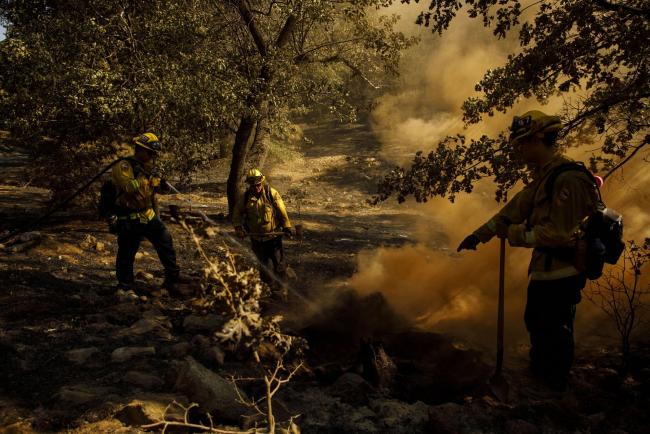(Bloomberg) -- As many as 10 million people across California may take turns being plunged into darkness on Monday evening as the state’s grid operator works to keep the region’s power system from collapsing under the strain of one of the worst heat waves in generations.
The outages, which were expected to hit as soon as 4 p.m. in California, would mark the third time in four days that the state’s utilities deliberately cut power to protect a grid that’s been pushed to the brink of failure as people blast their air conditioners and fans to keep cool. The state is facing an electricity shortfall on Monday of about 4.4 gigawatts, according to California Governor Gavin Newsom. That’s the equivalent of about four nuclear power plants.
“Let me just make this crystal clear: We failed to predict and plan these shortages -- and that’s simply unacceptable,” said Newsom, who called for an investigation into why officials failed to anticipate the need for blackouts.
Shortly after 3:30 p.m, the state’s grid operator declare a stage-two grid emergency -- one step away from a blackout order.
Since Friday, millions of Californians have been abruptly plunged into darkness with little notice, reminiscent of the mass blackouts that the state’s utilities carried out less than a year ago to keep their electrical lines from sparking fires during unusually strong windstorms -- all extreme weather events made more frequent by climate change. But even last year’s outages pale in comparison to the one planned for Monday. Rarely if ever have 3.3 million homes and businesses across California, or roughly 10 million people based on the average size of a household, been affected by a planned shutdown of this kind.
And it couldn’t be hitting California at a more vulnerable time, with the pandemic forcing people into lockdown, leaving them with little choice but to endure the heat indoors.
The rotating blackouts will last for about an hour each, according to the state’s grid operator. This month is the first time California has resorted to rotating outages since the 2001 energy crisis, when hundreds of thousands of customers lost power, electricity prices surged to record levels and the state’s largest electric utility went bankrupt. (It went bankrupt a second time last year in the face of crippling wildfire liabilities.)
Part of the problem is California’s rapid shift away from natural gas. About 9 gigawatts of gas generation, enough to power 6.8 million homes, have been retired over the past five years as the state turns increasingly to renewables, according to BloombergNEF. That leaves fewer options when the sun sets and solar production wanes.
Normally, California can import enough power from neighboring states when supplies are tight. But the sprawling heat wave blanketing the U.S. West is pushing power plants to the hilt across the region.
“California is in a tight spot,” BNEF analyst Brian Bartholomew said. “It’s retired a lot of gas. And the storage that’s supposed to help hasn’t yet come online.”
Tonight could be the grid’s biggest test yet, with temperatures expected to soar as high as 110 degrees Fahrenheit (43 Celsius) in some parts of the state. Heat in some parts of the region has already broken records.
“We don’t have enough resources,” John Phipps, director of real time operations at the California Independent System Operator, said on a conference call. “We’re going to have to” call for blackouts.
Newsom, a Democrat, signed an order that will temporarily allow users and utilities to use backup generators to ease the need for blackouts.
By 3 p.m. local time, it was already 102 degrees in Sacramento. With temperatures climbing, demand for power in the state is expected to reach more than 49,700 megawatts Monday afternoon, just shy of the all-time record set in 2006. Power prices more than doubled, to the highest in five months.
Read More: Blame Climate Change for Heatwave Misery: Green Insight
The relentless heat is starting to take a physical toll on California’s power system. Transformers -- the metal cylinders sitting atop power poles -- can malfunction and catch fire if they don’t cool off at night. And temperatures in some parts of Southern California are expected to remain in the low 80’s overnight. During a deadly, 10-day heatwave in 2006, the state’s utilities lost more than 1,500 of these devices, with each knocking out service to one neighborhood in the process.
The heat wave gripping the West Coast stems from a stubborn, high-pressure system that has parked itself across the Great Basin spanning Nevada and other western states. It essentially acts as a lid trapping hot air, and there aren’t any indications it’s going to budge soon.
Such phenomenons, sometimes called heat domes, are getting worse because the Earth’s climate is changing. As the planet warms, the contrast between the heat at the equator and the cold at the pole decreases. That saps the strength of the jet stream, which otherwise would be able to shove the ridges out of the way. It explains in part why extreme heat has blanketed regions around the world in recent weeks.
Read More: Japan’s Heat Wave Matches Record as Tokyo Death Toll Rises to 53
Extreme weather has taken a profound toll on electrical grids in recent weeks. Earlier this month, millions of people lost power across the U.S. Midwest after a wall of lightning, hail and deadly winds tore a path of ruin from central Iowa to Chicago. Days earlier, Tropical Storm Isaias darkened millions of homes from the Carolinas to Connecticut.
Soaring temperatures have already shattered records across California. According to the National Weather Service, Los Angeles International Airport hit a daily record of 93 degrees, breaking a previous high of 85 set in 1994. Death Valley reached 130 degrees for the first time since 1913. If validated, the weather service said, it will go down as the hottest August temperature there ever.
(Adds stage-two emergency in fourth paragraph.)
©2020 Bloomberg L.P.
